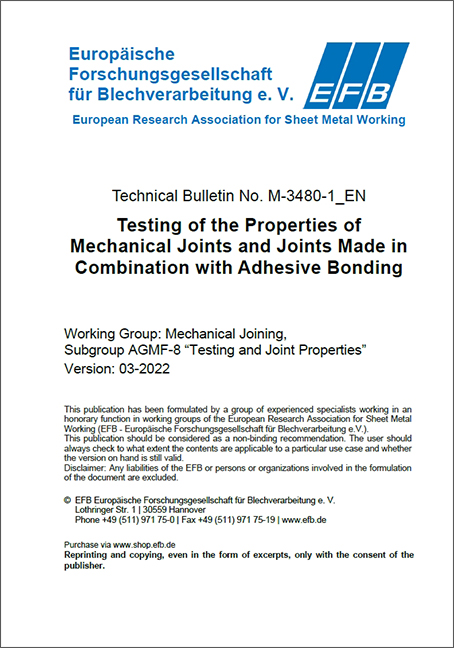Testing of the Properties of Mechanical Joints and Joints Made in Combination with Adhesive Bonding
Medien-Nr.:
MB-3480-1_EN
Produktnummer:
MB_3480-1_EN
Herausgeber:
Working Group: Mechanical Joining, Subgroup AGMF-8 “Testing and Joint Properties”
Erscheinungsjahr:
1. Juli 2022
Seitenanzahl:
35
This technical bulletin provides an overview of test methods for mechanical and combined mechanical joints with additional adhesive bonding. The specimen forms and test methods are described, with reference made to other applicable standards and regulations. Mechanically joined and additionally adhesive bonded joints are also referred to below as hybrid joints.
Contents
Keywords
1 Introduction
2 Scope of application
3 Preliminary considerations
4 Specimen shapes
4.1 Single-point specimen shapes
4.1.1 Single lap shear tensile specimen
4.1.2 Overlapped peel tensile specimen
4.1.3 Single-shear overlapping cross tensile test
4.1.4 KS2 specimen
4.2 Multi-point specimens
4.2.1 Two-point single-shear overlapped specimens
4.2.2 H specimen
4.2.3 Closed profile specimens
4.3 Specimen shapes for functional elements
4.4 Comparison of the specimen shapes
5 Test procedure
5.1 General information
5.2 Testing under quasistatic (rapid) loading
5.2.1 Testing with single-point specimens
5.2.2 Testing with shear, peel and cross tensile specimens
5.2.3 Testing with KS2 specimen
5.2.4 Testing of multi-point specimens
5.3 Testing under cyclical loading
5.4 Testing of single-point specimens under impact loading
5.5 Testing of component-like specimens under impact loading
5.6 Test methods specific to joining systems
5.6.1 Testing of functional elements
5.6.2 Blind rivet testing
5.7 Corrosion and aging testing methods
5.7.1 Important standard
5.8 Non-destructive test methods
5.9 Metallographic testing methods
6 References
7 Standards
Structures made by mechanical joining are subject to a wide variety of static, cyclic and impact loads and load combinations, and sometimes exposed to the effects of corrosion at the same time. Together with the materials used and the structural shape, the joining technology is key to the stiffness and strength behavior of the assemblies.
To compare different joining processes, all test conditions must be kept constant.
In the future, engineers will have to choose between an increasingly wide range of joining technologies, materials and adapted structural designs. This bulletin should support to identify adequate and reliable solutions in a relative quick and easy way.
To ensure the required quality of a specific mechanical joint, the correlation between the quality features and the variables that determine the joinability of the components have to be taken into account. The joinability depends on the suitability of the material for being joined, the reli-ability of the structure when joined and the robust conditions of joining in the production process.
The quality of a mechanical joint is determined by its fulfilment of defined requirements for the joining zone and the component.
The quality control of mechanical and hybrid joints can be carried out by destructive and non-destructive methods. Based on the system, the mechanical joints are divided into the follo-wing categories for further consideration:
- Clinch joints, self-pierce riveting joints, blind rivet joints and lock bolt joints
- Joints of type a) combined with adhesive bonding to hybrid joints
- Functional elements (self-piercing nuts, self-piercing bolts etc.)
To compare different joining processes, all test conditions must be kept constant.
Contents
Keywords
1 Introduction
2 Scope of application
3 Preliminary considerations
4 Specimen shapes
4.1 Single-point specimen shapes
4.1.1 Single lap shear tensile specimen
4.1.2 Overlapped peel tensile specimen
4.1.3 Single-shear overlapping cross tensile test
4.1.4 KS2 specimen
4.2 Multi-point specimens
4.2.1 Two-point single-shear overlapped specimens
4.2.2 H specimen
4.2.3 Closed profile specimens
4.3 Specimen shapes for functional elements
4.4 Comparison of the specimen shapes
5 Test procedure
5.1 General information
5.2 Testing under quasistatic (rapid) loading
5.2.1 Testing with single-point specimens
5.2.2 Testing with shear, peel and cross tensile specimens
5.2.3 Testing with KS2 specimen
5.2.4 Testing of multi-point specimens
5.3 Testing under cyclical loading
5.4 Testing of single-point specimens under impact loading
5.5 Testing of component-like specimens under impact loading
5.6 Test methods specific to joining systems
5.6.1 Testing of functional elements
5.6.2 Blind rivet testing
5.7 Corrosion and aging testing methods
5.7.1 Important standard
5.8 Non-destructive test methods
5.9 Metallographic testing methods
6 References
7 Standards

